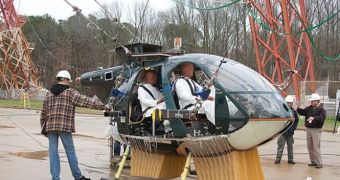When airplanes have to make a forced landing, the pilots can in some cases make a safe landing, using the mass of the aircraft as a glider, and setting the metal bird down on rivers, icebergs, or even short runways. But the same cannot be said about helicopters. When these machines go defective, they seriously jeopardize the lives of the crew and passengers, and experts have been working on ways of making them safer for many years. Now, engineers at a NASA lab are working on adapting technology originally developed for space flight to civilian applications, LiveScience reports.
The target of the new studies is a cushioning device known as a deployable energy absorber (DEA). According to scientists at the Langley, Virginia-based NASA Landing and Impact Research Facility, it could be that, in the near-future, helicopters outfitted with this new system could become a lot safer to their crews and passengers, thus improving related safety statistics. An MD-500 machine was intentionally crashed at the test facility two times recently, as engineers sought to gather more data on how the DEA operates, and what is its effectiveness level. In both simulations, the helicopter was suspended on wires, and then dropped from a height of about 35 feet (11 meters).
The end result was the simulation of a relatively-strong ground impact. The helicopter slammed into the ground at 33 miles (55 kilometers) per hour, which is the real-life equivalent of a survivable crash. Naturally, designing systems to keep people safe inside these flying machines as they hit the ground at 200 miles per hour is close to impossible. In each of the trials, in excess of one hundred sensors, and several video cameras, recorded the effects of the DEA, and analyzed the distribution and absorption of forces as the helicopters slammed into the concrete.
Inside the cockpit, the NASA engineers placed dummies not unlike those used to simulate car crashes. Sensors on each of the mannequins were meant to give researchers an idea of how the force of the impact would distort the bodies of those inside the helicopter. “We had minimal damage from first test, but we saw quite a bit more damage in the second test,” says of the results aerospace engineer Karen Jackson, who is based at the NASA Langley Research Center, in Hampton, Virginia. The second test drop was performed without the DEA device. After that, the helicopter was too damaged to run more experiments.

 14 DAY TRIAL //
14 DAY TRIAL //